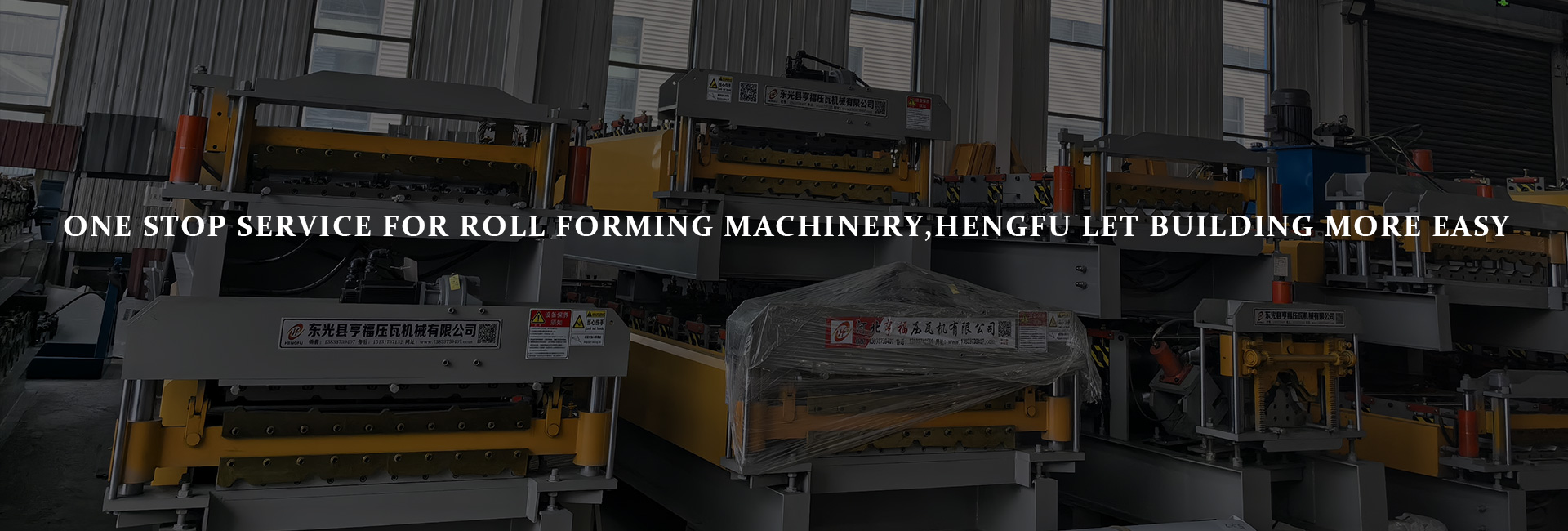In the field of architectural decorative material production, Wall Sheet Roll Forming Machine are key equipment for achieving efficient and precise production. As the construction industry's requirements for wall panel quality and production efficiency continue to rise, mastering the maintenance skills of roll forming machines not only ensures stable equipment operation but also significantly extends their service life, reducing enterprise production costs. This article provides a comprehensive analysis of the maintenance points of Wall Sheet Roll Forming Machine, offering practical guidance for practitioners.
I. Basic Understanding of Wall Sheet Roll Forming Machine
(A) Equipment Definition and Functional Overview
A wall panel roll forming machine is a specialized device that gradually applies pressure to metal sheets through multiple sets of rollers to shape them according to preset designs. Its main function is to process flat metal sheets into various types of wall panels, such as corrugated panels and profiled panels, which are widely used in the wall construction of industrial plants, warehouses, and civil buildings. Leveraging the technical characteristics of continuous roll forming, this equipment can efficiently produce wall panels with uniform specifications and stable quality, meeting the diverse needs of construction projects.
(B) Core Components
Roll Forming System: Composed of multiple sets of corresponding upper and lower rollers with different shapes, it is the core structure for sheet forming. The combination and arrangement of different rollers determine the final shape and size of the wall panels.
Transmission Device: Responsible for transmitting power to the roll forming system and driving the rollers to rotate. Common transmission methods include gear transmission and chain transmission, ensuring stable and uniform roller operation.
Control System: Accurately regulates equipment operating parameters, such as roll forming speed and pressure, through automated programs to ensure the accuracy and stability of the forming process. Additionally, the control system has a fault diagnosis function, facilitating the timely detection of equipment abnormalities.
(C) Mainstream Model Classifications
Based on production needs and technical characteristics, Wall Sheet Roll Forming Machine can be classified into single-layer and double-layer forming machines. Single-layer forming machines are suitable for producing wall panels of a single specification, with a relatively simple structure and lower cost. Double-layer forming machines can simultaneously produce two different types of sheets, offering higher production efficiency and suitable for large-scale and diversified production scenarios. Furthermore, according to the degree of automation, they can be divided into semi-automatic and fully automatic forming machines. The latter has functions such as automatic feeding, cutting, and stacking, greatly reducing manual intervention and improving production efficiency.
(D) Key Technical Parameters
Forming Speed: Directly affects production efficiency and is usually measured by the forming length per minute. A faster forming speed results in more wall panels produced per unit time, but it is necessary to balance forming quality to avoid sheet deformation or dimensional deviations due to excessive speed.
Sheet Applicability Range: Includes parameters such as sheet material (e.g., galvanized sheet, color-coated sheet), thickness, and width. Different models have varying applicability ranges for sheets, and the equipment should be selected based on actual production needs.
Accuracy Indicators: Mainly refer to the error ranges of the formed wall panels in terms of size, flatness, corrugation height, etc. High-precision forming machines can reduce the scrap rate, minimize material waste, and enhance product quality.
II. Core Maintenance Points
(A) Daily Cleaning and Inspection
Surface Cleaning: After daily work, promptly remove metal debris, oil stains, and other impurities from the equipment surface to prevent them from entering the equipment interior and affecting the normal operation of rollers and transmission components. Use a clean cloth or specialized cleaning tools for wiping, avoiding the use of corrosive cleaners.
Component Inspection: Regularly inspect the roller surfaces of the roll forming system for wear and scratches, check the gears and chains of the transmission device for looseness or wear, and ensure the instruments and buttons of the control system are functioning normally. If abnormalities are found, promptly shut down the equipment for handling to prevent the deterioration of problems.
(B) Lubrication Maintenance
Lubrication Parts: Regularly lubricate the bearings of the roll forming system, the chains and gears of the transmission device, and the screw nuts. These components generate friction during equipment operation, and proper lubrication can reduce wear, lower energy consumption, and extend the service life of the components.
Lubrication Cycle and Oil Selection: Formulate a reasonable lubrication cycle based on the equipment's usage frequency and working environment. Generally, equipment in continuous operation should be lubricated at least once a week. For equipment in high-temperature and high-dust environments, the lubrication cycle should be appropriately shortened. Select suitable lubricating oils or greases with good anti-wear and anti-oxidation properties.
(C) Electrical System Maintenance
Line Inspection: Regularly check the electrical lines for aging, damage, or looseness, promptly replace damaged lines, and tighten the wiring terminals to prevent safety accidents such as short circuits and electric leakage caused by line problems.
Control System Maintenance: Keep the control system clean to prevent dust and moisture from entering. Regularly back up the control programs to prevent data loss. If the control system malfunctions, it should be inspected and repaired by professional technicians. Do not disassemble or modify the programs without authorization.
III. Fault Prevention and Response
(A) Common Fault Types
Forming Quality Issues: Such as the appearance of wave-like shapes, large dimensional deviations, and surface scratches on wall panels, which may be caused by roller wear, uneven pressure, or unqualified sheet materials.
Transmission Faults: Manifest as abnormal noises, excessive vibrations, or unstable roller speeds during equipment operation, which may be caused by loose or worn transmission components or poor lubrication.
Electrical Faults: Including problems such as the equipment's inability to start, control system failure, and motor overheating, which are mostly caused by line faults, damaged electrical components, or program errors.
(B) Preventive Measures
Standardized Operation: Operators should strictly follow the equipment operation procedures to avoid faults caused by improper operation. For example, when changing the sheet specification, the parameters of the roll forming system should be adjusted first to ensure the equipment is in normal operation.
Regular Maintenance: Strictly implement the equipment maintenance plan and carry out preventive replacement of key components, such as bearings and chains that have reached their service life. At the same time, conduct comprehensive inspections and debugging of the equipment regularly to promptly detect and eliminate potential fault hazards.
(C) Emergency Handling
If the equipment malfunctions, immediately shut it down and cut off the power supply. Under the premise of ensuring safety, conduct a preliminary inspection of the fault to determine its cause. For simple faults, such as loose screws or material jams, they can be repaired by oneself. If the fault is more complex, promptly contact professional maintenance personnel to avoid blind disassembly of the equipment, which may cause secondary damage.
IV. Selection and Usage Recommendations
(A) Model Selection Points
Project Demand Matching: Select the appropriate model based on the production scale and wall panel specification requirements. If the production scale is small and the specifications are single, a single-layer semi-automatic forming machine can be selected. If the production needs are diversified and the scale is large, a double-layer fully automatic forming machine should be considered.
Performance Parameter Consideration: Focus on parameters such as the forming speed, accuracy indicators, and sheet applicability range of the forming machine to ensure the equipment can meet production quality and efficiency requirements. At the same time, understand the equipment's energy consumption and choose energy-saving products to reduce production costs.
(B) Brand and After-sales Support
Prioritize brands with good market reputation and high visibility, as their product quality and technical level are relatively more guaranteed. In addition, a comprehensive after-sales service system is also crucial, including equipment installation and debugging, operator training, regular maintenance, and rapid-response fault repair services. This can reduce equipment downtime and ensure production continuity.
(C) Industry Certification and Safety Standards
Ensure that the selected wall panel roll forming machine complies with relevant national safety standards and industry certification requirements, such as CE certification and ISO quality management system certification. These certifications are important guarantees for equipment quality and safety, helping enterprises avoid production risks and enhance product competitiveness.
V. Industry Trends and Future Outlook
(A) Intelligent Upgrades
With the development of artificial intelligence and Internet of Things technologies, Wall Sheet Roll Forming Machine will upgrade towards intelligence. Future equipment is expected to achieve AI regulation, automatically adjusting the forming process according to parameters such as sheet material and thickness to improve production accuracy and efficiency. At the same time, remote monitoring functions will allow managers to grasp the equipment's operation status in real time and promptly carry out fault warnings and maintenance arrangements.
(B) Application of Green and Environmental Protection Technologies
Against the backdrop of increasingly strict environmental protection policies, forming machines will pay more attention to energy consumption optimization and material recycling. New equipment may adopt energy-saving motors and efficient transmission systems to reduce energy consumption during the production process. At the same time, research and development of recyclable molds and auxiliary materials will reduce waste emissions and achieve green production.
(C) Market Competition and Technical Iteration
The intensification of market competition will drive the technological iteration of the wall panel roll forming machine industry. Enterprises need to continuously increase R & D investment, improve the automation and intelligence level of equipment, and develop new products that meet market demands. At the same time, by optimizing production processes and reducing costs, enterprises can enhance the cost-effectiveness of products and strengthen market competitiveness.
VI. Conclusion
Wall Sheet Roll Forming Machine are important equipment for the production of architectural decorative materials, and their maintenance directly affects the equipment's performance, service life, and the enterprise's economic benefits. By mastering the basic understanding of the equipment, implementing maintenance points, doing a good job in fault prevention and response, and reasonably selecting and using the equipment, the stability of equipment operation can be effectively improved, and the service life can be extended, providing strong support for the efficient and high-quality development of the construction industry. If you wish to further understand the selection schemes or maintenance techniques of Wall Sheet Roll Forming Machine, please continue to pay attention to relevant content.







